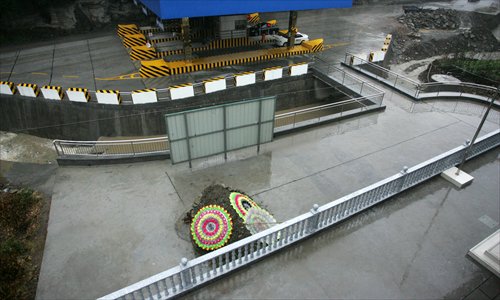HOME >> CHINA
Grave consequences
By Ding Xuezhen Source:Global Times Published: 2016-4-13 19:48:01
Govt vows reform despite failure of tomb-removal campaign

A grave still stands on the premises of a land resource bureau in Yuan'an, Central China's Hubei Province. The deceased's relatives and the department could not reach an agreement on compensation. Photo: CFP
Four years after a controversial tomb-removal campaign swept across the fertile and populous plains of Central China, its lessons are here to stay even though its changes are not.Most of the 3,000 cemeteries built as part of the tomb-removal campaign in Zhoukou, Henan Province, during which a total of 3.5 million graves were bulldozed within a year, are now abandoned and most of the tombs that were flattened have been re-built, The Beijing News reported.
Starting in March 2012, the campaign soon triggered controversy and incurred criticism among communities who saw their generations-old burial traditions being swept aside.
The campaign was part of national plans to gradually replace Chinese burial traditions with cremation. The national drive aims to save space for future development and farming and to curb problems such as so-called "nail graves" that stand awkwardly in middle of roads or buildings due to locals' refusal to move them.
A tomb in Taiyuan, North China's Shanxi Province was relocated in 2012 after standing in the middle of a construction site and preventing two residential buildings being completed for three years, news portal chinanews.com reported.
Tear down tombs
The campaign ended in November 2012 after the State Council removed a clause that allowed government authorities to destroy tombs by force from the country's funeral and internment management regulations.
As a result, Yue Wenhai, then mayor of Zhoukou, resigned in June 2013 and Zhu Wei, a village official who had set an example by removing his ancestral graves and eventually managed to flatten 1,043 tombs in his village in a single day, was removed from his post and expelled from the Party following an investigation by the local disciplinary department in 2014.
A total of 50,000 mu (3,333 hectares) of arable land was occupied by 3 million tombs in Zhoukou, where a population of 12.38 million share some 12 million mu of cultivated land, making the cultivated land per capita in many of the city's counties less than one mu, People's Daily reported in 2012.
"In terms of agricultural production, the increase in arable area [brought about by the tomb-removal campaign] is a good thing for mechanized farming," Zhang Yuanhong, a research fellow at the Rural Development Institute of the Chinese Academy of Social Sciences, told the Global Times.
However, the campaign cannot be evaluated simply by its economic benefits in agriculture, Zhang noted.
Zhang said that it may cause damage to "something in society, ethics and culture such as neighborhood harmony."
The Zhoukou government's three-year plan to remove all tombs from farmland was virtually completed within one year. By the end of November 2012, nearly 2.5 million tombs had been removed and some 30,000 mu of arable land reclaimed, the Farmers' Daily reported.
Such an "arbitrary and stormy" campaign should be avoided as Chinese people have the age-old tradition of visiting their ancestors' and relatives' tombs to hold rituals in honor of them, according to Zheng Fengtian, a vice dean of the School of Agricultural Economics and Rural Development at the Renmin University of China.
If the government wanted to restore the farmland occupied by the tombs, they should have first built cemeteries and then guided farmers to move the tombs there "with proper rituals and appropriate compensation," Zheng added.
Ashes to ashes
In the Chinese mainland, 45.6 percent of the 9.77 million people who died in 2014 were cremated, a drop of nearly 4 percentage points compared with the cremation rate in 2012, while the cremation rate in Taiwan surpassed 90 percent for the first time in 2009 after gradual growth from 45.71 percent in 1993.
The Ministry of Civil Affairs vowed in April 2014 to level up China's cremation rate to nearly 100 percent by 2020 in a drive to propel forward reforms which will save space for future development and farming.
In May 2014, authorities in Anqing, Central China's Anhui Province, required that from June 1, 2014 all its residents be cremated after they die, which reportedly led to the suicides in May of at least six elderly people who wanted to be buried.
The rash campaigns of the past seem to have not been effective in promoting cremation in the countryside, as "promoting cremation by force made it psychologically unacceptable to people," Dang Guoying, an expert on rural development with the Chinese Academy of Social Sciences said.
"More discretion is needed and more respects should be paid to public opinion" in future promotion of funeral reforms, Zhang noted.
Posted in: Society